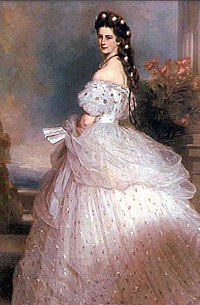History of fashion design

Okay, so people have been wearing clothes for a really long time, like since the beginning of civilization (which means when people started living in cities). At first, people just wore clothes to keep themselves warm and protect their bodies. But over time, they started to care about how they looked in their clothes too.
In different parts of the world, people came up with different styles of clothing. For example, in ancient Greece, people wore togas (which were basically long robes). In medieval Europe, women wore long dresses with tight corsets, and men wore big poofy pants called breeches.
Fashion design really took off during the Renaissance (which was a time of great art and learning in Europe). Artists started creating fancy clothes for rich people to wear. These clothes were often very elaborate, with lots of intricate designs and decorations. They were meant to show off how wealthy and important the wearer was.
During the 1700s and 1800s, fashion continued to evolve. Women's dresses became even more elaborate, with huge skirts and lots of ruffles and lace. Men's clothes were a bit simpler, but they still had specific styles for different occasions (like formal events versus everyday wear).
In the early 1900s, fashion really started to change. Women's dresses became more streamlined and practical, with shorter hemlines and simpler designs. This was partly due to the changing role of women in society - they were starting to work outside the home more, so they needed clothes that were easy to move in.
Throughout the 20th century, fashion continued to change rapidly. In the 1920s, women started wearing shorter dresses and more masculine-looking styles. In the 1950s, there was a big trend for full skirts and tiny waists (thanks to the popularity of movie star Marilyn Monroe).
These days, fashion is still changing all the time. Designers are always coming up with new ideas and styles for people to wear. Some trends stick around for a long time (like skinny jeans), while others come and go quickly (like bellbottoms). But no matter what, fashion will continue to be an important part of our culture and history.
In different parts of the world, people came up with different styles of clothing. For example, in ancient Greece, people wore togas (which were basically long robes). In medieval Europe, women wore long dresses with tight corsets, and men wore big poofy pants called breeches.
Fashion design really took off during the Renaissance (which was a time of great art and learning in Europe). Artists started creating fancy clothes for rich people to wear. These clothes were often very elaborate, with lots of intricate designs and decorations. They were meant to show off how wealthy and important the wearer was.
During the 1700s and 1800s, fashion continued to evolve. Women's dresses became even more elaborate, with huge skirts and lots of ruffles and lace. Men's clothes were a bit simpler, but they still had specific styles for different occasions (like formal events versus everyday wear).
In the early 1900s, fashion really started to change. Women's dresses became more streamlined and practical, with shorter hemlines and simpler designs. This was partly due to the changing role of women in society - they were starting to work outside the home more, so they needed clothes that were easy to move in.
Throughout the 20th century, fashion continued to change rapidly. In the 1920s, women started wearing shorter dresses and more masculine-looking styles. In the 1950s, there was a big trend for full skirts and tiny waists (thanks to the popularity of movie star Marilyn Monroe).
These days, fashion is still changing all the time. Designers are always coming up with new ideas and styles for people to wear. Some trends stick around for a long time (like skinny jeans), while others come and go quickly (like bellbottoms). But no matter what, fashion will continue to be an important part of our culture and history.
Related topics others have asked about:
